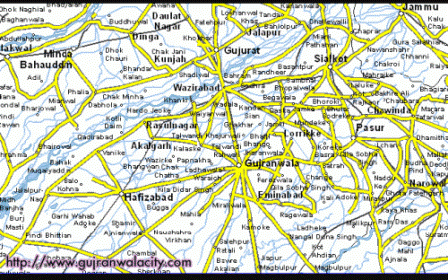 |
Gujranwala District ( ضِلع گُوجرانٚوالا), is a district in Punjab, Pakistan. Gujranwala city appears to be 500 years old.The origin of the name Gujranwala is shrouded in mists of time.The first name of the settlement according to the compilers of the first edition of the districtGazette was khanpur Shansi after an individual of the JAT cast called Khan Shansi who founded 11 villages in the nearby area. For some reason the Jaat Tribe Gujar occupied the land.They reach such dominance that the town came to be known as Gujranwala.It seems likely that the district once contained the capital of the Punjab, at an epoch when Lahore had not begun to exist. After the decline of the Mughal Empire, the Sikhs invaded and occupied Gujranwala District. Sayyid Ahmad and Shah Ismail Shaheed with volunteer Muslims were defeated and martyred by the professional Sikh Army. During the rise of Sikhs, the agricultural lands of Gujranwala were seized from Muslims by the military Sikh adventurers who then sprang up. |
|
|
Charat Singh, the grandfather of Maharaja Ranjit Singh, occupied the village of Gujranwala, then an inconsiderable hamlet, and made it the headquarters of himself and of his son and grandson. Minor Sikh chieftains occupied and settled at Wazirabad, Sheikhupura, and other towns; while in the western portion of the district the MuslimChatha Jats and Bhatti Rajputs maintained a sturdy independence. In the end, however, he succeeded in bringing all the scattered portions of the District under his own power. |
||
In 1847 the District came under British occupation and two years later, in 1849, it was included in the territory annexed after the second Sikh War. A cantonment was established at Wazirabad, which was abolished in 1855. The District formed a part originally of the extensive District of Wazirabad, which comprised the whole upper portion of the Rechna Doab.
In 1852 this unwieldy territory was divided between Gujranwala and Sialkot District. The District, as then constituted, stretched across the entire plateau, from the Chenab to the Ravi; but in 1853 the south-eastern fringe, consisting of 303 villages, was transferred to Lahore District, and three years later a second batch of 324 villages was handed over to the same District. There was no outbreak during the Indian Rebellion of 1857 and the Hindus and Sikh rallied to the side of Government with the greatest enthusiasm while Muslims rallied for the Mughals. According to the 1901 census the District had a population of 890,577 and contained 8 towns and 1,331 villages. Its population according to the 1881 census was 616,892 rising to 690,169 in 1891. The population increased by 29 per cent between 1891 and 1901 - the increase being greatest in the Hafizabad and Khangah Dogran tahsils, owing to the extension of canal-irrigation and the colonisation of the Bar. At the time the district was divided into four tehsils, namely: Gujranwala, Wazirabad, Hafizabad and Khangah Dogran (the headquarters of each being at the place from which it is named). The chief towns during British rule were the municipalities of Gujranwala, the headquarters of the District, Wazirabad, Ramnagar, Akalgarh, Eminabad, Kila Didar Singh, and the notified area of Sodhra. During the British era, the district of Gujranwala was part of Lahore Division. The predominantly Muslim population supported Muslim League and Pakistan Movement. After the independence of Pakistan in 1947, the minority Hindus and Sikhs migrated to India while the Muslim refugees from India settled in the Mandi Gujranwala District.
Language
Punjabi dialects, as per the 1998 census of Pakistan, Punjabi language is spoken by 95%. District Headquarters being fourth biggest and in centre of Punjab province has great variety of Punjabi dialects spoken by different district's people living in the city.
Other languages include:
- Dogri/Darhab (Jammu and Narowal district's people)
- Ghebi (Pindi Gheb Tehsil's people)
- Riasti (Bahawalpur Lodhran and Rahim Yar Khan districts people)
- Derawali (Rajanpur,Dera Ghazi Khan districts people)
- Multani/Saraiki (Multan and Lodhran districts people)
- Jandali (Jand Tehsil and Mianwali district's people)
- Chhachi (Attock Tehsil's people)
- Hindko (Hazara Division's people)
- Thalochi (Bhakkar,Layyah and Muzzaffargarh District's people)
- Chenavari(Tehsil Athara Tehsil Jhang's people)
- Jangli/Rachnavi (Sahiwal Distrct's people)
- Jhangochi (Khanewal and Jhang District's people)
- Shah puri (Sargodha division's people)
- Dhani (Chakwal district's people)
- Pahari (Tehsil Muree, Kotli sattian & AJK's people)
- Pothohari (Rawalpindi and Jehlum's Districts people)
- Majhi or Standard (Majority)
- Urdu being national language is spoken and understood
- English is also understood and spoken by the sizable educated people
Demography
According to the 1998 census of Pakistan the population of district was 3,400,940 of which 50.17% were urban. It is thus the third-most advanced district in Punjab, the population now stands at 4,308,905.
The district was composed of 5 tehsils:
- Gujranwala City
- Gujranwala Saddar
- Kamoke Tehsil
- Nowshera Virkan
- Wazirabad Tehsil
Now according to the new local government ordinance, Gujranwala is a City District consists of the following towns:
- Khiali Shahpure
- Aroop
- Nandipure
- Qila Didar Singh
- Wazirabad
- Kamonki
- Nowshehra Virkan
